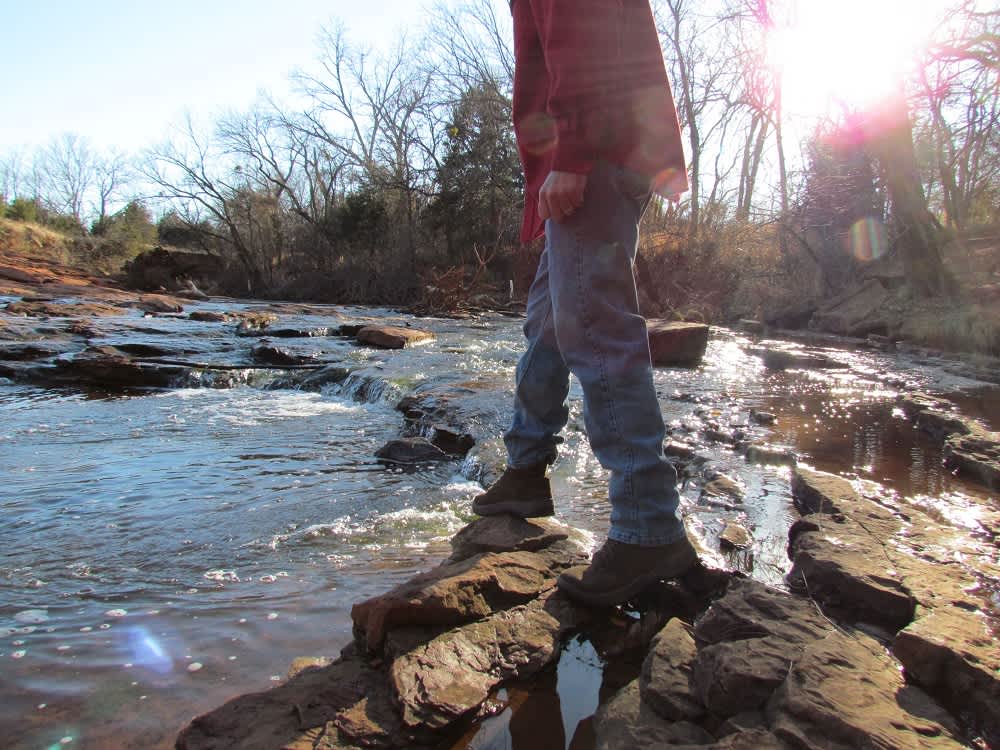Five Precautions Hikers Should Take During a Mild Winter
Andy and Tami McDaniels 02.18.13

The winter in Oklahoma has been rather mild this year. So mild in fact that it is not uncommon to see folks walking around during the day in short-sleeve shirts and shorts.
No matter where in the United States you live, hikers beware. Don’t be lured into taking a winter hike without making the proper preparations. The days are shorter and streams, while not frozen, could very likely be ice-cold, and the ground could be wet from snow. In addition, mild winters bring ticks and other insects out early, and the welcome rays of sunshine are still a threat to our skin.
For a fun and safe hike in mild winter weather, follow these tips.
Protect your skin
Lather on the sunscreen and spray on the insect repellant. It’s as easy to get sunburned in the winter as it is in the summer. Also, according to entomologists, one of the drawbacks of a mild winter is that ticks come out early. As a general rule, the CDC states that sunscreen should be applied before the bug spray.

Dress in layers
Oklahomans know how to dress for weather. As the saying goes, “If you don’t like the weather in Oklahoma, wait a minute.” In Oklahoma, as on the trail, the key is to dress in layers that you can pull off and on as the weather dictates. In general, the three main layers are wicking, insulating, and weather protection.
- Wicking is the layer of clothing worn next to your skin. It should be made of a fabric that will absorb moisture and pull it away from your body.
- Insulating is the layer that will keep the cold out and heat in. This middle layer includes sweaters, sweatshirts, and pull-overs. Fleece and wool are popular insulation materials.
- Weather protection is the exterior layer of clothing which serves as your protection against the elements. This layer should be waterproof and breathable.
Accessorize
Wear a hat and sunglasses. Bring gloves. Between 60-70 percent of your body’s heat can escape through an uncovered head. Hats, helmets, headbands–the choices are endless. Choose one suitable for the weather and activity and bring another one along just in case. Sunglasses do more than make you look cool on the trail; they protect your eyes from damaging UV rays and can prevent an accident by allowing you to properly discern terrain.
Stay hydrated
Most people associate dehydration with hot weather. However, dehydration occurs when you lose more fluids than you take in, and can occur in any weather. In milder weather you may underestimate fluid loss due to sweating. Hydration is essential to supplying energy to the body and facilitating heat production. If the weather should turn cold, dehydration adversely affects the body’s resistance to cold weather injuries. Stay hydrated by drinking plenty of water and/or other liquids, and avoid drinking alcoholic beverages.
Keep your feet dry
Trench foot, also called immersion foot, is a non-freezing injury that can occur in anyone who is exposed to cold water (32-60 degrees Fahrenheit) or who wears wet shoes or socks for long periods of time in the cold. The constant cold wetness injures blood vessels that bring nutrition to your feet and causes soft tissue damage. The best prevention is to keep your feet dry. Wear waterproof hiking shoes/boots that allow your feet to breathe, and carry an extra pair of socks with you in a waterproof packet.
Mild weather beckons you. Go for it. Just remember to be safe. The tips above are very basic and are meant to serve novice hikers considering a short trek from civilization in mild winter weather. In other words, these tips are for hikers who want to end the day in the comfort and warmth of their own beds.

